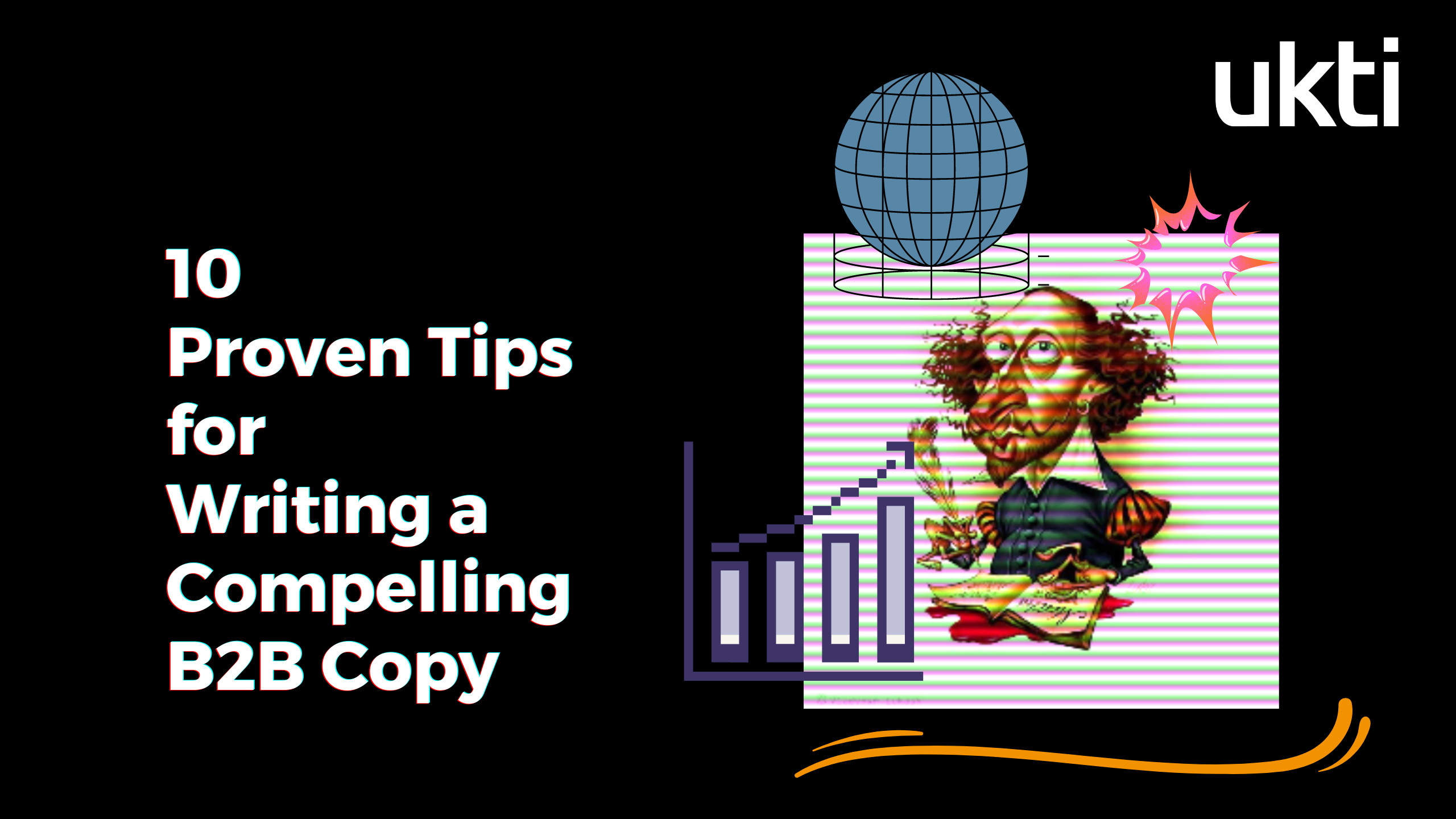Writing a B2B marketing copy that stands out is hard work, without a doubt. (Take it from someone who has spent way too much time figuring it out!)
But if you want to get better at B2B copywriting, think of it this way.
When your audience comes looking for information about your solution, what information do they want the most?
This will help you understand their key requirements and show them how your solution will address their pain points. So, you can write from a place of a problem-solver, and not just as an advocate of the solution.
Creating a compelling B2B copy is a challenging art. And whether or not you’re an artist, here are my 10 practical B2B writing tips that’ll help you ace your copy.
- 10 Tips to Nail Your B2B Content Writing
- Define Your Audience
- Use Active Voice
- Back Claims with Data
- Write in Short Paragraphs
- Use a Conversational Tone
- Answer the ‘How’ Instead of the ‘What’
- Show, Don’t Tell
- Include a CTA
- Proofread Before You Post
- Throw Perfection Out the Window
- Final Takeaways
10 Tried & Tested Tips to Nail Your B2B Content Writing
1. Define Your Audience
Yes, yes. It’s cliché advice, but is it always followed?
Not really.
But if you want to assemble a successful copy, you must understand who needs the products and services you’re writing about. If you don’t know your target audience, it’ll show in your writing.
If you’re writing for a client, ask for a buyer persona. That’s the shortest route to paint a picture of your audience and start drafting to them.
If not, get as specific as you can.
- Why would your reader want what you’re selling?
- Will it help them overcome a challenge like inability to keep track of bills?
- What emotions do you want the reader to feel when they’re reading the copy?
- What might stop them from saying ‘yes’ to your product?
Answering such questions will help you create targeted content that is relevant to your audience. This will be your base for everything: the tone you use, the topics you write about, the channels you use to communicate with your audience, etc.
2. Use Active Voice
Active voice is something that should be used by you more often.
Wait.
Let’s try it again.
You must use an active voice.
Better, isn’t it? A small change from passive to active can make your content more concise, powerful, and easier to consume. The tone is direct, so you’re more likely to grab your reader’s attention.
Active voice helps you sound confident and write with authority as opposed to passive voice, which makes you sound unsure. So, the next time you want to influence your readers with a strong argument, you know what to do.
Let’s look at a quick B2B writing example to understand.
- Passive voice: Our solution is customized to fit the requirements of our customers.
- Active voice: We customize our solution to fit all your requirements.
Here’s another B2B writing example that gets it right. It speaks clearly to the audience and highlights keywords they want readers to take away.
Source: andcards, coworking space software
3. Back Claims with Data
When it comes to B2B content writing, there’s nothing more compelling than industry data to back your claims. Take WordPress’s landing page for example. Their tagline reads ‘43% of the web is built on WordPress’.
Source: WordPress
They’re not only claiming to be the world’s most popular website builder, but they also have solid data to back it up. Which is a highly effective way of writing a copy, because customers tend to trust brands that base their claims on evidence.
For example, instead of saying ‘many B2B marketers use LinkedIn as their primary channel of client communication’, say ‘X% of B2B marketers use LinkedIn as their primary channel for communication’.
This converts a vague idea into a distinct number that readers can visualize with ease. And it instantly makes your content more credible.
That said, you must only use trusted and primary sources of data and link them appropriately.
4. Write in Short Paragraphs
Huge walls of text don’t give readers time to pause and end up discouraging readers to keep reading till the end. When you write in short paragraphs, however, it creates white space, making your copy easier to consume.
A rule of thumb? Don’t exceed 150 words in a paragraph and add breaks in the form of catchy subheads.
To learn how, consider HubSpot’s example. This marketing and sales software brand cleverly sections its blogs to present information in a digestible format. So, users can quickly find the information they’re looking for.
They even follow the same format in their survey reports and product and service descriptions.
5. Use a Conversational Tone
In simple words, write the way you would speak
- to a colleague you admire
- to a help desk worker
- to your high school teacher
In a tone that’s friendly, unassuming, careful, and witty. But don’t – just don’t – write like you speak. Here’s why.
As Erica Schneider explains on LinkedIn,
Now, you’ve probably heard of the B2B writing tip that you must maintain a professional tone from start to end. And while it’s not entirely false, it’s not completely true either.
Confused? Let me break it down for you.
A conversational tone helps you connect with your audience better. It makes them feel that you’re talking directly to them instead of some random person on the internet.
That said, you must determine the level of formality you need to build credibility for your target audience, and the topic at hand.
Regardless of how “technical” or “formal” your topic is, you can use these simple B2B writing tips to make your copy more engaging-
- Use simple words in the active voice (“use” instead of “leverage”)
- Use questions to engage your audience
- Address them with the word ‘you’
6. Answer the ‘How’ Instead of the ‘What’
Another common B2B writing practice is going on and on about the benefits of your products or services.
If that’s you, it’s time to change your tactics. Instead of highlighting ‘what’ your solution can do, address ‘how’ exactly will it benefit the reader.
Why?
Because B2B buyers go into a product search knowing what they want. So when they visit your website, they’re looking for details and want you to address their objections.
Take the example of Basecamp. This is a section on their landing page explaining how they, as a project management platform, are different from others.
Source: Basecamp
This is a great example of how you can highlight what difference your product or service will make to their business and why you are the best solution to their problem.
Start at the bottom of the sales funnel, and remember: the goal is to position your brand as the default choice.
7. Show, Don’t Tell
This is essentially an extension of the last point. While it’s important to tell your audience what makes your brand stand out, backing it up with evidence will be a game-changer.
Are you marketing a software that is compatible with multiple platforms? Offer a free demo. Are you claiming 100% customer satisfaction? Back it up with client testimonials. You can also use infographics, images, explainer videos, etc. as evidence to build rapport and credibility among your audience.
This will give them an added push towards making a purchase decision.
Carrying the example of Basecamp from the previous section, see how they do it so well.
8. Include a CTA
The concept of content marketing isn’t new. From startups to MNCs, businesses across sizes and industries are striving to create value for their readers.
Be it ‘how-to guides’ or ‘industry-specific best practices’, your audience comes first when creating a marketing copy. But in the process, don’t forget to create value for your brand too.
The ultimate goal of B2B marketing content is generating potential leads. And for this, you must include relevant CTAs.
It can either be to download a piece of gated content, inquire about more details, or simply purchase the product. You can do this in two ways:
- Direct approach – Tell your audience exactly what to do. For example, ‘drop us an email to get more information’.
Indirect approach – Hint at the CTA without being too pushy. For example, adding relevant hyperlinks.
9. Proofread Before You Post
Pretty obvious, right? But if I had a penny for every time I saw a sloppy mistake on a website, I’d be, well, let’s say, not looking at price tags anymore.
In the world of texting, punctuation errors or spelling mistakes have become acceptable to many. But they’re a strict no-no when it comes to B2B content writing.
Even an honest mistake can take away from your authority and credibility, especially when your audience comprises key decision-makers. So, make sure you proofread the copy yourself or ask someone else to do it before hitting the ‘Publish’ button.
You can also use free online tools to ensure your copy is grammatically correct. Grammarly and GrammarCheck are great options!
10. Throw Perfection Out the Window
It’s important that your B2B copy is high-quality but you don’t have to strive for perfection when you’re just starting out. And if you’re like me, you might not even be close.
The number of times I had to rework my initial B2B copies was frustrating but also grounding.
If you set unattainable standards for yourself, you’ll feel like a failure right from the beginning. Remember, your audience is more interested in the details of your products or services instead of your writing style or technique.
So don’t worry if you feel a sentence could’ve been better or you should’ve retained the data. As long as your spelling and grammar are on point, you’re good to go.
Final Takeaways
B2B writing can be tricky. And when you know your audience comprises top business executives, it can be all the more intimidating. But with these simple B2B writing tips, you’ll be able to nail your marketing copy in no time.
For the best results, make sure you A/B test all your copies to understand what resonates with your audience the most and incorporate it into your marketing strategies moving forward. And if you need help with B2B content writing, you know who to contact.


10 thoughts on “10 Proven Tips for Writing a Compelling B2B Copy”